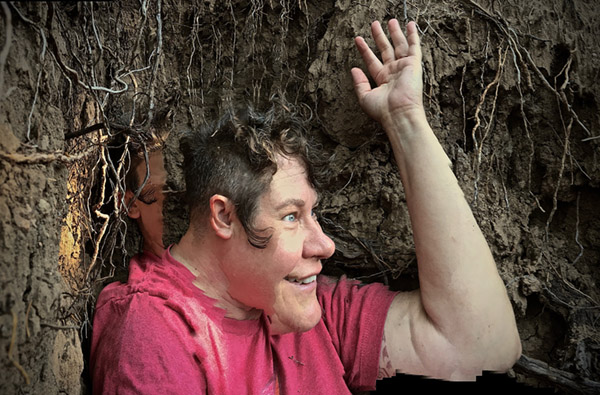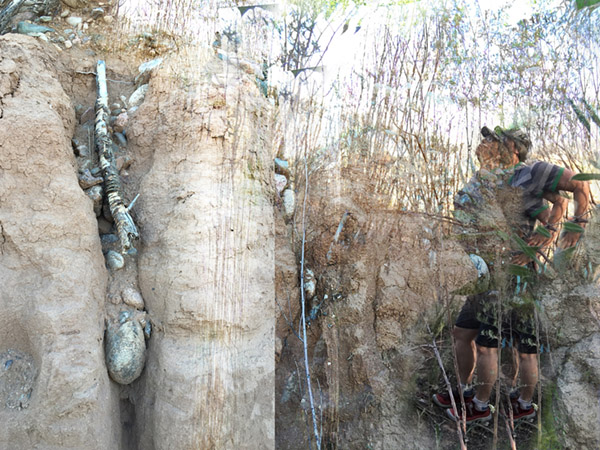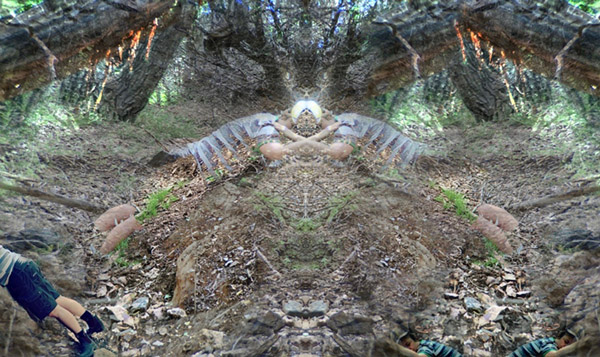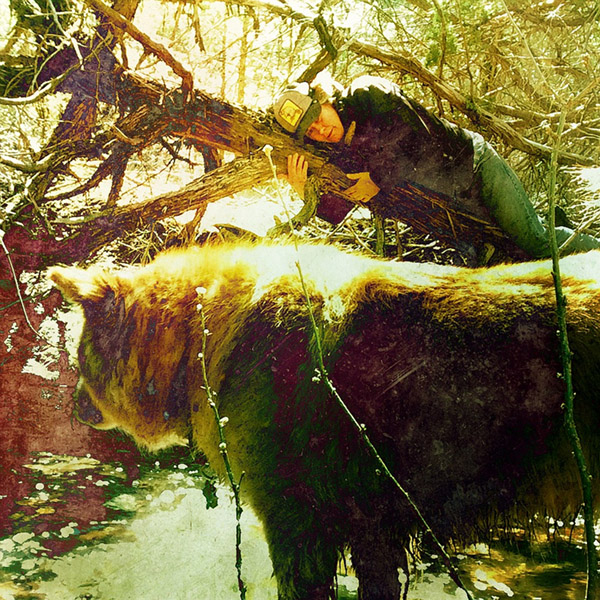Being in Body in Nature on Earth
An Interview with Ahjo
Ahjo is a neuro different, gender queer, pansexual, elemental creature, residing for more than 25 years on Tewa land at O’gha Po’oge—White Shell Water Place—now called Santa Fe, New Mexico. Ahjo calls themselves a SomaticEarth Artist and uses all mediums to express both the tension and wonderment of this relationship. They are currently working on a book, EarthBodyBoat: Journey of a SomaticEarth Artist.
~~
Before I answer the questions, I’d like to offer a “score” for those interested in exploring my responses in an embodied and curious way. I’ll add other parts of the score throughout the interview. They can be experienced as pauses, an opportunity to come back into yourself and participate.
Before reading, if you’re sitting, stand up. If you’re standing, sit down. Take a minute to look around the space you are in and name out loud three “beings.” For example, Hello there, dirty Dishes. Hello, yellow-leaved Tree. Hello, Carpet keeping my feet warm. Write the names of these three beings down.
~~
What does your current somatic/artistic practice look like?
The score above, and woven throughout this interview, is an example of one of my practices. Scoring can be used in one’s everyday life to increase engagement and stimulate creativity. Honestly, I haven’t used them that way so much but have been inspired to more lately. Mostly I’ve used them in nature to create a ritualistic container for extended embodied explorations with the elements—what I call InBodyNature practice.
Like all my practices, the form often shifts, and it seems that part of the practice is noticing those seasonal, necessary shifts. Not judging. Not doubting. Not believing I’m failing. For instance, I haven’t been using planned scores in nature recently; rather, I find myself spontaneously doing rituals. Maybe this is because I’ve spent so much time already in the structure of scores. Scores help me remember to let myself be led by sensations—to remember to touch, listen to sounds, make sounds, move from different body parts, and engage with elements I don’t normally feel compelled to connect with. One of the ideas of these scores is/was to break out of old patterns of movement and ways of perceiving. I have much quicker access to that now, at least in nature. Staying embodied and enlivened is still difficult for me while inside buildings, in everyday life. The above score, if I actually would do it periodically while working at a computer, would be radical for me.
Back to the shifting nature of my practice: Because of chronic illness, I had to let go of seeing or calling myself a dancer. One of the biggest gifts in this has been this embracing of a changing practice and appreciation for more subtle expressions of movement. Movement is everywhere. It’s in how we grow and it’s in all aspects of our being—
in walking the same path everyday,
in laying our body down in a crack of Earth as prayer,
in visualizing and sensing ourselves as a Tree of Life,
in letting tears turn into howls and song,
in writing a poem to document an experience of frustration.
At the heart of all this is sensing for connection to my soma so that I may better connect to Earth’s soma and all beings, alive and in spirit. There can be long seasons of what feels like drought when the body and emotions are in contraction. A refusal to connect can show up. The practice then is to hold space for that, embracing this as my soma’s way of saying, “We need to rest and draw inward.” To me, knowing these places is just as valuable as some external goal of arrival or mark of success. This is learning the terrain of the human soma.
Then, there’s the art. Ha! Sometimes it’s difficult for me to discern between practice and art. In my InBodyNature practice, there are times when a shift of consciousness happens that is similar to my experience of doing improvisational dance in a studio. All the senses are alert and the witness self becomes active in creating and being in relationship with the place and elements. Am I creating art even though there are no human witnesses? Am I performing, or are we then nature, Nature as Creation itself? Of course, I can’t resist trying to document this. Is the documentation process the true art? I’ve used words, composite photography, video and some performance. Over time there has been a longing to bring messages back, to find a way to translate, to encourage others to find solace within their own bodies and the body of earth, to remember and repair these sacred relationships.
~~
Pause, place your hands somewhere on your body, and listen for sensations. Name out loud three sensations (i.e. tightness in mid back, taste of milk in mouth, coolness on skin). Write them down.
~~
How would you describe somatics to someone unfamiliar with the term?
I’ve actually struggled with the word “somatic.” It feels so intellectual (to my body). Yet it seems better than using the word “body.” Like the old idea that the Inuit peoples of the north have over 50 words for “ice,” I wish we had 50 words for “body.” “Body,” as a word, has been colonized, its meaning limited by colonial and patriarchal structures and ideologies that view the body as a machine or vehicle similar to a car (“go, go, go…!”). Western culture has lost its indigenous, pagan ways of experiencing and relating to (meaning having a relationship with) our bodies as a living organism connected to all other organisms within the one living body of Earth. Hence, the necessity for a word that embraces all that—soma. And somatics, to me, is the study of that.
Naming myself a SomaticEarth Artist is my way of saying I am committed to the study of this relationship and to expressing from this awareness, including grief and any emotional, physical or spiritual illness arising from my/our disconnection from the organic, wise way of EarthBody.
~~
Pause, place your hands somewhere on your body, and listen for emotions. Name out loud three feelings you are having. Write them down.
~~
You also have a writing practice and are about to come out with a book – how does writing inform your somatic practice or vice versa?
I have to backtrack to give some history first. When I was very young I loved writing, as well as making up stories and dances to perform. But gradually, because I was socialized as a girl, I experienced greater approval when my body performed than when I communicated with words. In my experience as a young person studying in the Chicago area in the 70s and 80s, dance was very separate from language. It’s been a long journey to honor both my words and body, and to find ways to connect them. Finding words has been an essential part of claiming wholeness. Two of the greatest influences in that have been a more recent study with Ruth Zaporah and a writing practice I learned at the Tamalpa Institute in 1989, similar to the score I’ll give at the end of the questions.
Another key influence has been dialogues with my brother who is a Jungian psychologist and nature quest guide with a background in literature. His approach is all about finding meaning and the importance of naming. At first this felt so foreign. Comparatively, my way of InBodyNature practice felt totally sensory or, in artistic terms, abstract. But gradually I really longed for meaning in my experiences. I kept having these characters show up, and eventually the characters themselves guided me to meaning and stories.
I’ve needed to understand my InBodyNature experiences as valuable, as meaningful. It’s easy, as with a nighttime dream, to believe “Oh, that was nothing.” But when you give space and time to write, even just a few key words, then writing becomes a bridge. Even though I’m fully embodied, these are “non-ordinary” or “altered state” experiences, so writing is a way to ground into everyday reality what comes from the unconscious and Mystery.
My book, EarthBodyBoat: Journey of a SomaticEarth Artist, has been pieced together from many writings over a period of six years. Some of them come from spontaneous social media postings that often felt more like improvisation. Others are poems directly from InBodyNature scores. I feel my somatic practice has given me a greater sense of self and with that I’m able to communicate more fluidly with words and have a voice.
It’s interesting to witness how the process of putting my writings (and photography) into what will some day be an actual book required me to return to the original moments and to feel and sense them again on a whole other level. In the process of compiling EarthBodyBoat, my somatic practice has deepened. I feel like the damage I experienced from the educational system (in both school and dance) has been healing. I wish I knew what is happening scientifically, but both my mind and body have grown smarter and hopefully less divided.
~~
Pause, place your hands over your eyes, and notice any images or associations that are coming into your mind. Write them down.
~~
What themes or issues are you most interested in exploring or tackling in your work?
I’ve spoken to a lot of that already, but it always comes back to EarthBody for me. I long not only for myself but also for all beings to feel safe. That they feel they belong within their individual bodies and expression, as well as belonging to place. There’s so much suffering in the world from not feeling safe to arrive, connect, feel, stay and share authentically—within oneself and outward. How do we connect outward if all inward systems are on high alert in freeze or flee responses? This is a very personal question that I struggle with and I see mirrored everywhere.
I’ve used my art, performances, photography and writings as a way for me to start making this connection outward. Art has been my safe container to share and show both moments of embodied earthly connection and the struggle to be my authentic queer creature self. Slowly, I’m able to show up, without dissociating, to engage in political communities that are meaningful to me.
~~
Pause, if your body could get up and move right now, what would it do? Visualize that movement. Name the movement’s qualities out loud and write them down.
~~
In your experience, are opportunities and access points for artists making work from a gender-blurring perspective getting better with time?
I/we would say probably not enough. But honestly, my self-identification as non-binary gendered is somewhat new. Even calling myself an artist is new. (I had a 15-year out-of-body, spiritual-sidetrack experience that’s taken me a long time to recover from.)
I will say I’m somewhat frustrated with art shows that are women-identified and not blatantly inclusive of trans femmes or those who have been socialized as female that identify as trans men, butch women and non-binary. But dang, that’s a lot of words to make events inclusive! It’s a strange time to be coming out (at the age of 53) as non-binary just as this resurgence of women’s voices is rising. I feel simultaneously connected and disconnected to the female experience.
~~
You should now have a list of “beings,” sensations, emotions, associations and movement qualities. Circle one or two words from each category and write a sentence or poem from them. Recite what you wrote out loud to another being.
My poem from doing above score:
Wake, burn, plant
Unfurl our throats
Yellow Spaciousness
Our eyes tired of grinding ice
~~
To learn more, visit ahjo.art.




